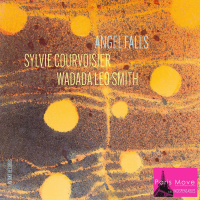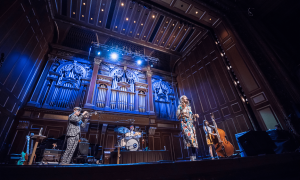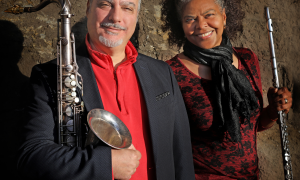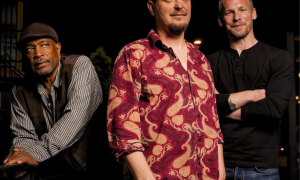
On Oct. 28, 1966, pianist Bill Evans was in Oslo, Norway, to play a concert with his trio and to accompany jazz singer Monica Zetterlund. The Scandinavian tour must have been a short one, since he had been at New York's Village Vanguard a week earlier and was there again 13 days later. Joining Evans in Oslo was bassist Eddie Gomez, who had been with him since the spring, and Danish drummer Alex Riel. It's unclear why Riel was on drums rather than a Norwegian drummer. Perhaps Riel was in town and was recommended to Evans, who didn't have a regular drummer at the time. Or he may have played with Evans and Gomez at a club the night before.
In the afternoon prior to the concert, Evans, Gomez and Riel were at a Norwegian television studio being taped as they rehearsed for the concert. Interestingly, the show's producer seemed to favor the same approach used by Robert Herridge in 1957 when he produced The Sound of Jazz for CBS: Let multiple cameras move freely about to capture the most interesting angles and images, and then punch in the best camera shots on the board in the control room.
The resulting video is one of the most amazing Bill Evans documents on film that I've seen—a 45-minute documentary-performance complete with pre-rehearsal banter, Evans's instructions to the producer and musicians, and multiple retakes of Five, his theme. The clip went up on YouTube March 6 and apparently comes from Riel's personal archive.
First I'll show you the clip.Then I'll tell what I learned about Evans from watching it. And finally, I'll show you part of the Zetterlund rehearsal and video from the concert that evening. First, the rehearsal clip (the songs are Very Early, Who Can I Turn To, If You Could See Me Now, Autumn Leaves and Five)...
Here what we learn about Bill Evans:
Evans wasn't a good geography student. This is what Evans says as he enters the studio, seemingly trying to paper over some sort of faux pas.
Evans wasn't a fan of the music shelf. He asks to have it removed from the piano, obviously so he can better hear the instrument.
Evans was forgetful. He brought along a large envelope, ostensibly filled with music and notes. But after looking inside for what he wanted, Evans does a 360 in confusion, as if he forgot something important behind at the hotel. Most likely it was the list of songs he had intended the trio to play.
The drums were still a bit player. Prior to 1968, Evans viewed the drums largely as ambient rhythm and not nearly as essential to the musical conversation as the bass. He asks to have visual contact with Eddie Gomez but is fine having the drums behind him, out of his line of sight.
Feel trumped rhythmic rigidity. Rather than flip out over forgetting his song list, Evans is quite calm while solving the problem. He comes up with four songs plus his theme and outlines how he plans to play them. At several points, he urges drummer Riel to relax and just feel the music rather than think about what he had to do with the brushes.
Evans was mellow in a crisis. After sitting down at the piano, Evans notices that the soft pedal's rod was displaced, keeping the pedal from working. Rather than curse the piano, he calmly asked to have it fixed.
Evans loved his own playing. Once he begins to play, Evans appears to fall into a trance at the mere sound of his own beautiful phrasing.
Norwegian assistants had judgment. When someone shows up with a glass of water for Evans, he waits momentarily until it dawns on him that both of Evans' hands are occupied. He turns and leaves promptly with the glass.
Riel may not have understood Evans completely. I'm not sure how much English Riel had under his belt at this time, but at times Riel doesn't seem to grasp Evans's direction. In all fairness, I'm sure it was the most nervous moment in Riel's career to have Evans explain something with Gomez looking on. I get the shivers just thinking about it.
Evans wanted to stay in the moment. Before they began, Riel seems to want a break after each song, in case of a goof he'd have a chance at a redo. Evans preferred to go straight through, with just a pause in between songs. Evans clearly abhorred overthinking jazz or anything that compromised emotion and feeling. Once they agree on Evans's approach, Gomez ribbed Riel by saying, “If you goof up, you'll get fired, that's all, not a problem."
Gomez had a heart. Before they start, Riel doesn't quite grasp how to handle Very Early. Gomez, who moments earlier shot Riel a zinger, offers to show him the music, so he can read it. Evans, eager to get going, eyes Riel like a hawk, trying to determine if he's on board. When Gomez and Riel return from their huddle, Evans once again emphasizes that the feel is more important than the notes.
Gomez was an extraordinary partner. His solos throughout the rehearsal are extraordinary, especially on Who Can I Turn To and Autumn Leaves. Interestingly, by Autumn Leaves, Riel was feeling the music rather than thinking about it.
Evans let a bad note slide. At the end of Autumn Leaves, instead of ending on the final note of the upper-register run, the bass note rings last, seemingly via the damper pedal. In fact, you can see him for a brief second wonder what caused the note to stick and he even looks down at the pedals. In the recording studio, that final sour note would have resulted in a retake. Here, Evans lets it pass.
Evans takes responsibility. On Five, Riel struggles on the odd theme to figure out where the brushes should fit in. At the end of the first take, Evans blames himself, noting he “sprung" the song on Riel. Evans tries to simplify what he wants by explaining that it should have a straightforward I Got Rhythm two-beat feel.
Evans was a teacher. Sensitive that Riel is still having trouble with the song after the next take, Evans stops and urges Riel to just play straight time and not to listen to him, because what he is playing is “so over the thing"—a priceless self-evaluation.
Evans asks for help. On the third take, Riel is still not playing behind Evans correctly, so Evans asks Gomez to play straight two-beat feel on the bridge, providing Riel with a guard rail of sorts.
Evans had a sense of humor. At the end, Evans stands and says, “That was easy."
Here's the Monica Zetterlund portion of the rehearsal, or at least one of several songs she rehearsed at the TV studio. It's Waltz for Debby, or Monica's Vals...
And here's the Bill Evans Trio portion of the Oslo concert that night...
In the afternoon prior to the concert, Evans, Gomez and Riel were at a Norwegian television studio being taped as they rehearsed for the concert. Interestingly, the show's producer seemed to favor the same approach used by Robert Herridge in 1957 when he produced The Sound of Jazz for CBS: Let multiple cameras move freely about to capture the most interesting angles and images, and then punch in the best camera shots on the board in the control room.
The resulting video is one of the most amazing Bill Evans documents on film that I've seen—a 45-minute documentary-performance complete with pre-rehearsal banter, Evans's instructions to the producer and musicians, and multiple retakes of Five, his theme. The clip went up on YouTube March 6 and apparently comes from Riel's personal archive.
First I'll show you the clip.Then I'll tell what I learned about Evans from watching it. And finally, I'll show you part of the Zetterlund rehearsal and video from the concert that evening. First, the rehearsal clip (the songs are Very Early, Who Can I Turn To, If You Could See Me Now, Autumn Leaves and Five)...
Here what we learn about Bill Evans:
Evans wasn't a good geography student. This is what Evans says as he enters the studio, seemingly trying to paper over some sort of faux pas.
Evans wasn't a fan of the music shelf. He asks to have it removed from the piano, obviously so he can better hear the instrument.
Evans was forgetful. He brought along a large envelope, ostensibly filled with music and notes. But after looking inside for what he wanted, Evans does a 360 in confusion, as if he forgot something important behind at the hotel. Most likely it was the list of songs he had intended the trio to play.
The drums were still a bit player. Prior to 1968, Evans viewed the drums largely as ambient rhythm and not nearly as essential to the musical conversation as the bass. He asks to have visual contact with Eddie Gomez but is fine having the drums behind him, out of his line of sight.
Feel trumped rhythmic rigidity. Rather than flip out over forgetting his song list, Evans is quite calm while solving the problem. He comes up with four songs plus his theme and outlines how he plans to play them. At several points, he urges drummer Riel to relax and just feel the music rather than think about what he had to do with the brushes.
Evans was mellow in a crisis. After sitting down at the piano, Evans notices that the soft pedal's rod was displaced, keeping the pedal from working. Rather than curse the piano, he calmly asked to have it fixed.
Evans loved his own playing. Once he begins to play, Evans appears to fall into a trance at the mere sound of his own beautiful phrasing.
Norwegian assistants had judgment. When someone shows up with a glass of water for Evans, he waits momentarily until it dawns on him that both of Evans' hands are occupied. He turns and leaves promptly with the glass.
Riel may not have understood Evans completely. I'm not sure how much English Riel had under his belt at this time, but at times Riel doesn't seem to grasp Evans's direction. In all fairness, I'm sure it was the most nervous moment in Riel's career to have Evans explain something with Gomez looking on. I get the shivers just thinking about it.
Evans wanted to stay in the moment. Before they began, Riel seems to want a break after each song, in case of a goof he'd have a chance at a redo. Evans preferred to go straight through, with just a pause in between songs. Evans clearly abhorred overthinking jazz or anything that compromised emotion and feeling. Once they agree on Evans's approach, Gomez ribbed Riel by saying, “If you goof up, you'll get fired, that's all, not a problem."
Gomez had a heart. Before they start, Riel doesn't quite grasp how to handle Very Early. Gomez, who moments earlier shot Riel a zinger, offers to show him the music, so he can read it. Evans, eager to get going, eyes Riel like a hawk, trying to determine if he's on board. When Gomez and Riel return from their huddle, Evans once again emphasizes that the feel is more important than the notes.
Gomez was an extraordinary partner. His solos throughout the rehearsal are extraordinary, especially on Who Can I Turn To and Autumn Leaves. Interestingly, by Autumn Leaves, Riel was feeling the music rather than thinking about it.
Evans let a bad note slide. At the end of Autumn Leaves, instead of ending on the final note of the upper-register run, the bass note rings last, seemingly via the damper pedal. In fact, you can see him for a brief second wonder what caused the note to stick and he even looks down at the pedals. In the recording studio, that final sour note would have resulted in a retake. Here, Evans lets it pass.
Evans takes responsibility. On Five, Riel struggles on the odd theme to figure out where the brushes should fit in. At the end of the first take, Evans blames himself, noting he “sprung" the song on Riel. Evans tries to simplify what he wants by explaining that it should have a straightforward I Got Rhythm two-beat feel.
Evans was a teacher. Sensitive that Riel is still having trouble with the song after the next take, Evans stops and urges Riel to just play straight time and not to listen to him, because what he is playing is “so over the thing"—a priceless self-evaluation.
Evans asks for help. On the third take, Riel is still not playing behind Evans correctly, so Evans asks Gomez to play straight two-beat feel on the bridge, providing Riel with a guard rail of sorts.
Evans had a sense of humor. At the end, Evans stands and says, “That was easy."
Here's the Monica Zetterlund portion of the rehearsal, or at least one of several songs she rehearsed at the TV studio. It's Waltz for Debby, or Monica's Vals...
And here's the Bill Evans Trio portion of the Oslo concert that night...
This story appears courtesy of JazzWax by Marc Myers.
Copyright © 2026. All rights reserved.

























